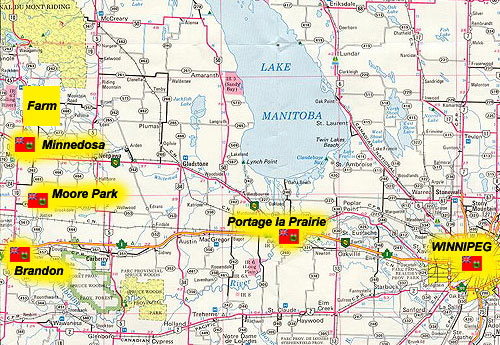| Home | Scotland | England | Canada | Cameron Family Tree | Comments/Contact |

Elaine
M. McCrorie
Regina,
Sask., Canada
|
Manitoba, Canada They were not poor immigrants. They had a salon cabin and a steerage cabin on the ship. They brought with them furniture and household goods including a chest of drawers, desk, mantel clock and brass candlesticks. The folklore in the family has two versions of their reason for immigrating. One story was that Andrew did not want his boys becoming coal miners, which was the only work available in the area. When you look at the census for 1901, you will see that many of their neighbours were coal miners. One young boy of age fourteen was a pony driver in the pits. The other story is that Andrew drank alcohol in excess and Martha hoped to change this pattern in a new environment. She had second thoughts when she saw the barren prairies and would have gladly returned to Britain. Over the next winter and spring Andrew looked for land on which to settle and in the spring of 1908 he had found land and the family moved to their new home. The legal description of the land was “that tract of land in the province of Manitoba and being composed of the south half of Section Twenty (20) in Township Thirteen (13) and Range Seventeen (17) West of the Principal Meridian in Said Province of Manitoba.
Manitoba had become a province in 1870 and that same year the land was surveyed using the Principal Meridian as a starting point. The survey divided and marked the area into square mile sections. The government encouraged immigration and settlement of the west. The parcel of land where Andrew settled his family had been homesteaded in 1884, so that some improvements to the land had already been made. The farm was rich black soil, dotted with sloughs (ponds), with some stones and wooded areas. There was a fairly large wooden house on the farm. The roads were only dirt trails. There was no electricity or water in the house. |
Note: All images on this site are property of Elaine M. McCrorie and may not be reproduced in any way without prior consent

Our thanks to Elaine
McCrorie for her hard
work and dedication in
the making of the
Manitoba Camerons.
The Camerons in Canada

Compiled by
Elaine McCrorie
